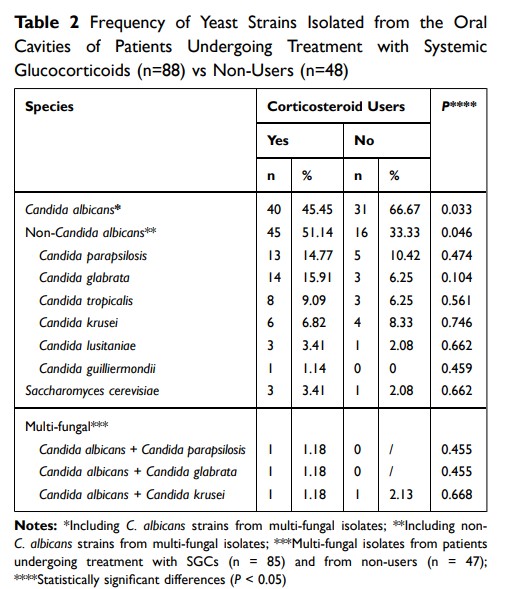108384
论文已发表
注册即可获取德孚的最新动态
IF 收录期刊
- 3.4 Breast Cancer (Dove Med Press)
- 3.2 Clin Epidemiol
- 2.6 Cancer Manag Res
- 2.9 Infect Drug Resist
- 3.7 Clin Interv Aging
- 5.1 Drug Des Dev Ther
- 3.1 Int J Chronic Obstr
- 6.6 Int J Nanomed
- 2.6 Int J Women's Health
- 2.9 Neuropsych Dis Treat
- 2.8 OncoTargets Ther
- 2.0 Patient Prefer Adher
- 2.2 Ther Clin Risk Manag
- 2.5 J Pain Res
- 3.0 Diabet Metab Synd Ob
- 3.2 Psychol Res Behav Ma
- 3.4 Nat Sci Sleep
- 1.8 Pharmgenomics Pers Med
- 2.0 Risk Manag Healthc Policy
- 4.1 J Inflamm Res
- 2.0 Int J Gen Med
- 3.4 J Hepatocell Carcinoma
- 3.0 J Asthma Allergy
- 2.2 Clin Cosmet Investig Dermatol
- 2.4 J Multidiscip Healthc

接受全身性糖皮质激素治疗患者的口腔念珠菌病的发病率及分离株对抗真菌药物的敏感性
Authors Xiao J, Xu G, de Hoog S, Qiao J, Fang H, Li Y
Received 14 May 2020
Accepted for publication 16 July 2020
Published 29 July 2020 Volume 2020:13 Pages 2601—2607
DOI https://doi.org/10.2147/IDR.S262311
Checked for plagiarism Yes
Review by Single anonymous peer review
Peer reviewer comments 2
Editor who approved publication: Professor Suresh Antony
Background: Candida species are commonly detected as colonizers of the oral cavity; candidiasis or candidemia can develop in patients who are immunocompromised. Use of topical or inhaled glucocorticoids can alter the spectrum of Candida species and can promote oral candidiasis. The present study aims to evaluate the diversity of Candida species in the oral cavity and their susceptibility to antifungal agents in patients undergoing treatment with systemic glucocorticoids (SGCs) compared with non-users.
Methods: We conducted a descriptive, analytical, cross-sectional study that enrolled 120 patients with oral problems who were undergoing treatment with SGCs and who were admitted to the hospital of the First Affiliated Hospital, College of Medicine, Zhejiang University and Zhejiang Hospital, Hangzhou, China, between February 2019 and September 2019. One hundred and twenty age-and sex-matched patients were recruited as the SGC non-user control group. Demographic data included oral complaints and underlying diseases; symptoms of oral candidiasis were identified on physical examination. Candida species were collected using a concentrated oral rinse. Identification of fungal isolates was based on conventional phenotypic methods assisted by DNA sequence analysis of the internal transcribed spacer (ITS) rDNA gene region. Antifungal activities of anidulafungin, amphotericin B, micafungin, caspofungin, 5-flucytosine, posaconazole, voriconazole, itraconazole, and fluconazole were evaluated using the Sensititre YeastOneTM YO10 panel supplemented by the CLSI-M27-A3 protocol.
Results: Fifty-two (43.33%) out of the 120 patients undergoing with SGCs were diagnosed with oral candidiasis, compared with 14 (11.67%) of the non-users (P < 0.05). Likewise, we collected 88 strains from 73.33% of the SGC users compared with only 48 (40%) from non-users (P < 0.05). Candida albicans was detected most frequently in both groups (45.45% vs 66.67%, respectively; P = 0.033); the overall frequency of non-Candida albicans (NCA) strains isolated from patients treated with SGCs were significantly higher than that identified among non-users (51.14% vs 33.33%, respectively; P = 0.046), although there were no significant differences concerning any single species of NCA. Resistance of C. albicans to itraconazole (P = 0.004) and fluconazole (P = 0.001) was significantly higher in patients treated with SGCs than in non-users; however, echinocandins, amphotericin B, voriconazole, and posaconazole were all active against strains from both participant groups with no significant differences detected.
Conclusion: Taken together, our findings indicate that SGC therapy may result in an increased prevalence of oral candidiasis as reflected by the clinical presentations and strains isolated; these findings were also associated with an increased frequency of NCA strains. SGC therapy was also associated with an increased frequency of C. albicans strains that were resistant to both itraconazole and fluconazole. The impact of SGC therapy on Candida species in the oral cavity requires further study.
Keywords: oral candidiasis, identification, antifungal susceptibility, systemic glucocorticoid therapy, Candida , azole resistance
